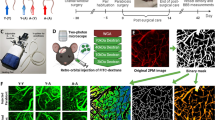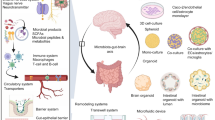Summary
A readily obtainable in vitro paradigm of the blood-brain barrier (BBB) would offer considerable benefits. Toward this end, in this study, we describe a novel method for purifying murine brain microvascular endothelial cells (BMEC) for culture. The method uses limited collagenase-dispase digestion of enriched brain microvessels, followed by immunoisolation of digested, microvascular fragments by magnetic beads coated with antibody to platelet-endothelial cell adhesion molecule-1. When plated onto collagen IV-coated surfaces, these fragments elaborated confluent monolayers of BMEC that expressed, as judged by immunocytochemistry, the adherens junction-associated proteins, VE-cadherin and β-catenin, as well as the tight junction (TJ)-associated proteins, claudin-5, occludin, and zonula occludin-1 (ZO-1), in concentrated fashion along intercellular borders. In contrast, cultures of an immortalized and transformed line of murine brain capillary-derived endothelial cells, bEND.3, displayed diffuse cytoplasmic localization of occludin and ZO-1. This difference in occludin and ZO-1 staining between the two endothelial cell types was also reflected in the extent of association of these proteins with the detergent-resistant cytoskeletal framework (CSK). Although both occludin and ZO-1 largely partitioned with the CSK fraction in BMEC, they were found predominantly in the soluble fraction of bEND.3 cells, and claudin-5 was found associated equally with both fractions in BMEC and bEND.3 cells. Moreover, detergent-extracted cultures of the BMEC retained pronounced immunostaining of occludin and ZO-1, but not claudin-5, along intercellular borders. Because both occludin and ZO-1 are thought to be functionally coupled to the detergent-resistant CSK and high expression of TJs is considered a seminal characteristic of the BBB, these results impart that this method of purifying murine BMEC provides a suitable platform to investigate BBB properties in vitro.
Similar content being viewed by others
References
Abbott, N. J.; Astrocyte-endothelial interactions and blood-brain barrier permeability. J. Anat. 200:629–638; 2002.
Allt, G.; Lawrenson, J. G. Pericytes: cell biology and pathology. Cells Tissues Organs 169:1–11; 2001.
Andersson, L. M.; Hagberg, L.; Fuchs, D.; Svennerholm, B.; Gisslen, M. Increased blood-brain barrier permeability in neuro-asymptomatic HIV-1-infected individuals—correlation with cerebrospinal fluid RNA and neopterin levels. J. Neurovirol. 7:542–547; 2001.
Andjelkovic, A. V.; Zochowski, M. R.; Morgan, F.; Pachter, J. S. Qualitative and quantitative analysis of monocyte transendothelial migration by confocal microscopy and three-dimensional image reconstruction. In Vitro Cell. Dev. Biol. 37A:111–120; 2001.
Bernardini, G.; Ribatti, D.; Spinetti, G.; Morbidelli, L.; Ziche, M.; Santoni, A.; Capograssi, M. C.; Napolitano, M. Analysis of the role of chemokines in angiogenesis. J. Immunol. Methods 273:83–101; 2003.
Brahic, M. Theiler's virus infection of the mouse, or: of the importance of studying mouse models. Virology 301:1–5; 2002.
Bussolino, F.; Mitola, S.; Serini, G.; Barillari, G.; Ensoli, B. Interactions between endothelial cells and HIV-1. Int. J. Biochem. Cell Biol. 33:371–390; 2001.
Carmeliet, P.; Collen, D. Molecular analysis of blood vessel formation and disease. Am. J. Physiol. 273:H2091-H2104; 1997.
Chen, M. L.; Pothoulakis, C.; LaMont, J. T. Protein kinase C signaling regulates 20-1 translocation and increased paracellular flux of T84 colonocytes exposed to Clostridium difficile toxin. A. J. Biol. Chem. 277:4247–4254; 2002.
Connolly, J. O.; Soga, N.; Guo, X. L.; Alvarez, U.; Hruska, K. A. Rac is essential in the transformation of endothelial cells by polyoma middle. T. Cell Adhes. Commun. 7:409–422; 2000.
Dong, Q. C.; Bernasconi, S.; Lostaglio, S., et al. A general strategy for isolation of endothelial cells from murine tissues. Characterization of two endothelial cell lines from the murine lung and subcutaneous sponge implants. Arterio. Thromb. Vasc. Biol. 17:1599–1604; 1997.
Dzenko, K. A.; Andjelkovic, A. V., Kuziel, W. A.; Pachter, J. S. The chemokine receptor CCR2 mediates the binding and internalization of monocyte chemoattractant protein-1 along brain microvessels. J. Neurosci. 21:9214–9223; 2001.
Fanning, A. S.; Jameson, B. J.; Jesaitis, L. A.; Anderson, J. M. The tight junction protein ZO-1 establishes a link between the trassmembrane protein occludin and the actin cytoskeleton. J. Biol. Chem. 273:29745–29753; 1998.
Fazakerley, J. K. Pathogenesis of Semliki Forest virus encephalitis. J. Neurovirol. 8:66–74; 2002.
Fazekas, G.; Tabira, T. What transgenic and knockout mouse animals teach us about experimental autoimmune encephalomyelitis. Rev. Immunogenet. 2:115–132; 2000.
Fenstermacher, J. D.; Nagaraja, T.; Davies, K. R. Overview of the structure and function of the blood-brain barrier in vivo. In: Kobiler, S.; Lustig, S.; Shapira, S., ed. Blood-brain barrier: drug delivery and brain pathology. New York: Kluwer Academic-Plenum Publishers; 2000:1–7.
Furuse, M.; Hirasi, M.; Itoh, A.; Nagafuchi, S.; Yonemura, S.; Tsukita, S.; Tsukita, S. Occludin: a novel integral membrane protein localizing at tight junctions. J. Cell Biol. 123:1777–1788; 1993.
Gold, R.; Hartung, H. P.; Toyka, K. V. Animal models for autoimmune demyelinating disorders of the nervous system. Mol. Med. Today 6:88–91; 2000.
Gumbleton, M.; Audus, K. L. Progress and limitations in the use of in vitro cell cultures toserve as a permeability screen for the blood-brain barrier. J. Pharma. Sci. 90:1671–1698; 2001.
Han, X.; Fink, M. P.; Delude, R. L. Proinflammatory cytokines cause NO*-dependent and-independent changes in expression and localization of tight junction proteins in intestinal epithelial cells. Shock 19:229–237; 2003.
Hayashi, T.; Noshita, N.; Sugawara, T.; Chan, P. H. Temporal profile of angiogenesis and expression of related genes in the brain after ischemia. J. Cereb. Blood Flow Metab. 23:166–180; 2003.
Helmke, B. P.; Thakker, D. B.; Goldman, R. D.; Davies, P. F. Spatiotemporal analysis of flow-induced intermediate filament displacement in living endothelial cells. Biophys. J. 80:184–194; 2001.
Hosoya, K.-I.; Tetsuka, K.; Nagase, K.; Tomi, M.; Saeki, S.; Ohtsuki, S.; Terasaki, T. Conditionally immortalized brain capillary endothelial cell lines established from a transgenic murine harboring temperature-sensitive simian virus 40 large T-antigen gene. AAPS PharmSci. 2:1–11; 2000.
Huber, J. D.; Egleton, R. D.; Davis, T. P. Molecular physiology and patho-physiology of tight junctions in the blood-brain barrier. Trends Neurosci. 24:719–725; 2001.
Jinno-Oue, A.; Wilt, S. G.; Hanson, C.; Dugger, N. V.; Hoffman, P. M.; Masuda, M.; Ruscetti, S. K. Expression of inducible nitric oxide synthase and elevation of tyrosine nitration of a 32-kilodalton cellular protein in brain capillary endothelial cells from rat infected with a neuropathogenic murine leukemia virus. J. Virol. 77:5145–5151; 2003.
Joo, F. The cerebral microvessels in culture, an update. J. Neurochem. 58:1–17; 1992.
Joo, F. The blood-brain barrier in vitro: the second decade. Neurochem. Int. 23:499–521; 1993.
Kalaria, R. N. Small vessel disease and Alzheimer's dementia: pathological considerations. Cerebrovasc. Dis. 13:48–52; 2002.
Kim, G. W.; Kondo, T.; Noshita, N.; Chan, P. H. Manganese peroxide dismutase exacerbates cerebral infarction after focal cerebral ischemia/reperfusion in mice: implications for the production and role of superoxide radicals. Stroke 33:809–815; 2002.
Lampugnani, M. G.; Corada, M.; Caveda, L.; Breviario, F.; Ayalon, O.; Geiger, B.; Dejana, E. The molecular organization of endothelial cell to cell junctions: differential association of plakoglobin, β-catenin, and α-catenin with vascular endothelial cadherin (VE-cadherin). J. Cell Biol. 129:203–214; 1995.
Lampugnani, M. G.; Resnati, M.; Raiteri, M.; Pigott, R.; Pisacane, A.; Houen, G.; Ruco, L. P.; Dejana, E. A novel endothelial-specific membrane protein is a marker of cell-cell contacts. J. Cell Biol. 118:1511–1522; 1992.
Leker, R. R.; Shohami, E.; Constantini, S. Experimental models of head trauma. Acta Neurochir. Suppl. 83:49–54; 2002.
Lossinsky, A. S.; Song, M. J.; Wisniewski, H. M. High voltage electron microscopic studies of endothelial cell tubular structures in the mouse blood-brain barrier following brain trauma. Acta Neuropathol. 77:480–488; 1989.
Miyakawa, T. Vascular pathology in Alzheimer's disease. Ann. NY Acad. Sci. 977:303–305; 2002.
Montesano, R.; Pepper, M. S.; Mohle-Steinleinl, U.; Risau, W.; Wagner, E. F.; Orci, L. Increased proteolytic activity is responsible for the aberrant morphogenetic behavior of endothelial cells expressing the middle T oncogene. Cell 62:435–445; 1990.
Muller, W. A.; Randolph, G. I. Migration of leukocytes across endothelium and beyond: molecules involved in the transmigration and fate of monocytes. J. Leuk. Biol. 66:698–704; 1999.
Nitta, T.; Hata, M.; Gotoh, S.; Seo Y.; Sasaki, H.; Hashimoto, N.; Furuse, M.; Tsukita, S. Size-selective loosening of the blood-brain barrier in claudin-5-deficient mice. J. Cell. Biol. 161:653–660; 2003.
Omidi, Y.; Campbell, L.; Barar, J.; Connell, D.; Akhtar, S.; Gumbleton, M. Evaluation of the immortalized murine brain capillary endothelial cell line b.End3, as an in vitro blood-brain barrier model for drug uptake and transport studies. Brain Res. 990:95–112; 2003.
Pachter, J. S. Association of mRNA with the cytoskeletal framework: its role in the regulation of gene expression. Crit. Rev. Euk. Gene Exp. 2:1–8; 1992.
Palladini, G.; Finardi, G.; Bellomo, G. Modifications of vimentin filament architecture and vimentin-nuclear interactions by cholesterol oxides in 73/73 endothelial cells. Exp. Cell Res. 223:83–90; 1996.
Parkinson, F. E.; Freisen, J.; Kriznac-Bengez, L.; Janigro, D. Use of a three-dimensional in vitro model to assay nucleoside efflux from brain. Brain Res. 980:233–241; 2003.
Plumb, J.; McQuaid, S.; Mirakhur, M.; Kirk, J. Abnormal endothelial tight junctions in active lesions and normal appearing white matter in multiple sclerosis. Brain Pathol. 12:154–169; 2002.
Rao, R. K.; Basuroy, S.; Rao, V. U.; Karnaky, K. J.; Jr.; Gupta, A. Tyrosine phosphorylation and dissociation of occludin-ZO-1 and E-cadherin beta-catenin complexes from the cytoskeleton by oxidative stress. Biochem. J. 368:471–481; 2002.
Rosenberg, G. A. Matrix metalloproteinases and neuroinflammation in multiple sclerosis. Neuroscientist 8:586–595; 2002.
Shaw, S. K.; Perkins, B. N.; Lim, Y. C.; Liu, Y.; Nusrat, A.; Schnell, F. J.; Parkos, C. A.; Luscinkas, F. W. Reduced expression of junctional adhesion molecule and platelet/endothelial cell adhesion molecule-1 (CS31) at human vascular endothelial junctions by cytokines tumor necrosis factor-alpha plus interferon gamma does not reduce leukocyte transmigration under flow. Am. J. Pathol. 159:2281–2291; 2001.
Song, L.; Pachter, J. S. Monocyte chemoattractant protein-1 alters expression of tight junction-associated proteins in brain microvascular endothelial cells. Microvasc. Res., in press. Available online Sept. 23, 2003. Hardcopy still in press.
Stumm, R. K.; Rummel, J.; Junker, V.; Culmsee, C.; Pfeiffer, M.; Krieglstein, J.; Hollt, V.; Schulz, S. A dual role for the SDF-1/CXCR4 chemokine receptor system in adult brain: isoform-selective regulation of SDF-1 expression modulates CXCR4-dependent neuronal plasticity and cerebral leukocyte recruitment after focal ischemia. J. Neurosci. 22:5865–5878; 2002.
Tsukita, S.; Furuse, M. Occludin and claudins in tight-junction strands: leading or supporting players? Trends Cell Biol. 9:268–273; 1999.
Wachtel, M.; Bollinger, M. E.; Ishihara, H.; Frei, K.; Bluethmann, H.; Gloor, S. M. Down-regulation of occludin expression in astrocytes by tumour necrosis factor (TNF) is mediated via TNF type-1 receptor and nuclear factor-kappaB activation. J. Neurochem. 78:155–162; 2001.
Wassmer, C. C.; Combes, V.; Grau, G. F. Pathophysiology of cerebral malaria: role of host cells in the modulation of cytoadhesion. Ann. NY Acad. Sci. 992:30–38; 2003.
Wijsman, J. A.; Shivers, R. R. Immortalized murine brain endothelial cells are ultrastructurally similar to endothelial cells and respond to astrocyte-conditioned medium. In Vitro Cell. Dev. Biol. 34A:777–784; 1998.
Wolburg, H.; Lippoldt, A. Tight junctions of the blood-brain barrier: development, composition and regulation. Vasc. Pharmacol. 38:323–337; 2002.
Wolburg, H.; Neuhaus, J.; Kniesel, U.; Krauss, B.; Schmid, E.-M.; Ocalan, M.; Farrell, C.; Risau, W. Modulation of tight junction structure in blood-brain barrier ECs. Effects of tissue culture, second messengers and cocultured astrocytes. J. Cell Sci. 107:1347–1357; 1994.
Author information
Authors and Affiliations
Corresponding author
Rights and permissions
About this article
Cite this article
Song, L., Pachter, J.S. Culture of murine brain microvascular endothelial cells that maintain expression and cytoskeletal association of tight junction-associated proteins. In Vitro Cell.Dev.Biol.-Animal 39, 313–320 (2003). https://doi.org/10.1290/1543-706X(2003)039<0313:COMBME>2.0.CO;2
Received:
Accepted:
Issue Date:
DOI: https://doi.org/10.1290/1543-706X(2003)039<0313:COMBME>2.0.CO;2




